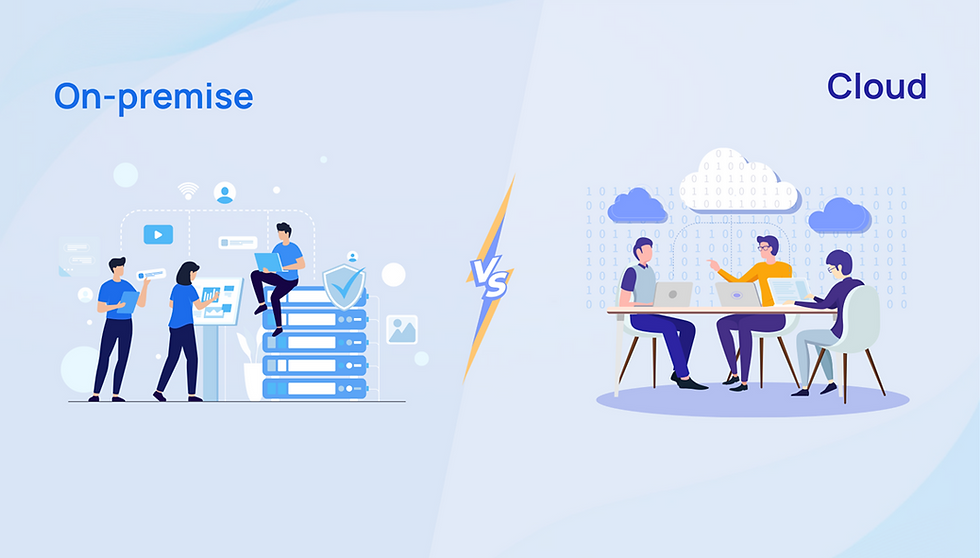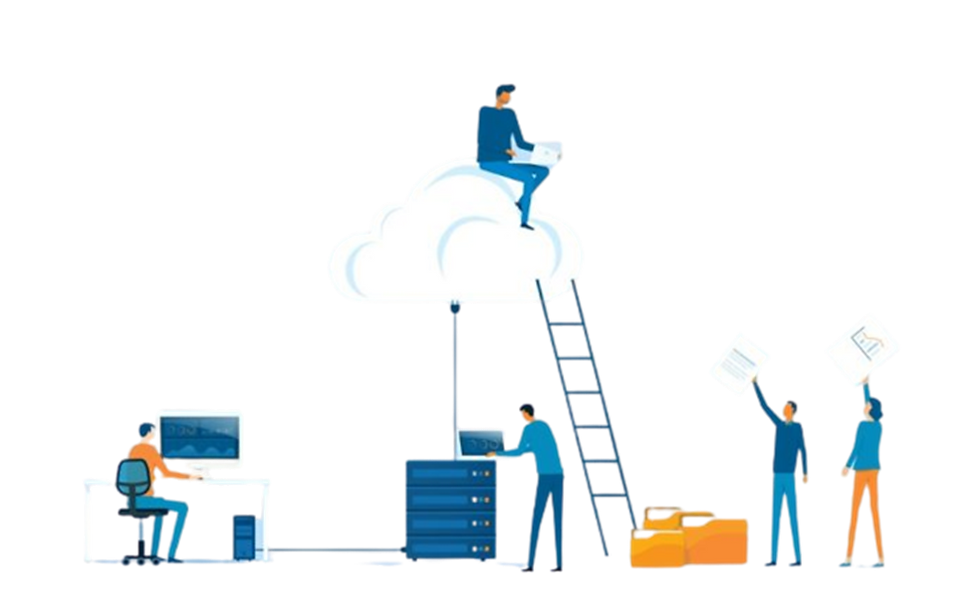Migrating from On-Prem to AWS
- ALIF Consulting
- Feb 13, 2023
- 8 min read
Updated: Jun 5, 2024
The decision to move from an on-prem data center to the cloud is one that is not only a strategic move to keep up with changing technology but also one that offers a significant business advantage for those who migrate successfully.
Amazon Web Services (AWS) has quickly emerged as the leading cloud provider in total enterprise usage, and for good reason. With an expansive library of resources and services, AWS has all you need to take your on-prem data center off your hands and provide greater accessibility, scalability, and security to help you meet your long-term goals.
Benefits of AWS vs On-Prem

Reduced hardware and maintenance expenses by just purchasing what is necessary when it is required.
Access anywhere, at any time.
Don't worry about upkeep, compatibility, or upgrades; everything is hosted for you.
Increased security.
prompt deployment
Scalability.
Decreased energy expenses.
High availability and emergency preparedness.
Allows you to put time and money into other breakthroughs by eliminating the hassle.
AWS itself has gathered data on the business value of migrating to AWS, including:
31% Average infrastructure cost savings
62% IT Staff Productivity Boost
94% Application Downtime Reduction
3x More Features delivered per year
It is obvious that the cloud has several benefits. But getting there requires effort. To ensure smooth sailing before, during, and after the migration begins, careful planning and preparation are essential for a successful migration.
Preparing for AWS Migration

It can be stressful and time-consuming to migrate to AWS. Planning carefully can help business leaders make sure that their migration to the cloud meets their existing technical, financial, and security needs. Because of inadequate planning beforehand, cloud migrations frequently fail. Giving executive leadership a clear understanding of your objectives, requirements, and expectations will help you get their support and put you on the correct path for a successful cloud migration.
STEP 1: DETERMINE YOUR BUSINESS OBJECTIVES
You must first ask yourself the most crucial question before moving forward with any migration efforts: "What is the aim of my cloud migration?" You might think that switching to the cloud is just the thing to do, and you'd be correct. However, if you don't have a strategy or an end goal in mind, you'll be spinning your wheels before you've even gotten off the ground. One of the most frequent causes of failure migration is not matching your cloud strategy with your business objectives, as we noted in our recent feature on cloud migration.
Establish Key Performance Indicators (KPIs) for your cloud migration strategy that reflect your organization's current state and your desired post-migration position. This will enable you to monitor your progress and determine whether or not your migration was truly beneficial. Do you desire greater security? Quicker reaction time? Enhanced cost-efficiency These are crucial inquiries that will affect the choices you make going forward with your cloud trip.
STEP 2: CHOOSE A CLOUD TYPE

Choosing the sort of cloud you wish to utilise is a crucial next stage in the planning process for your cloud migration. The goals you specified in the previous stage will guide your choice, and each sort of cloud (public, private, and hybrid) serves a different function. In Cloud Migration: A Key to Your Business Advantage, you may read about the advantages and disadvantages of various cloud types. But ultimately, how much you want to manage your cloud will influence which model you choose.
Prepared to fully commit to the cloud? You might benefit from using public or private solutions. Alternatively, a hybrid plan can be the best option for you if you decide that you'll need to keep at least some of your data center.
STEP 3: PREPARING A TEAM

Organizing a team for a successful cloud transfer requires a few crucial elements.
Dedicated Leadersh
To begin with, leaders need to be devoted and all-in. While the migration process won't always go well, without a bold leader setting the bar high, your teams will find it difficult to persevere.
Train Your Teams
After your leadership has adopted the proper mindset, it's time to enlist the support of your teams. By educating your teams on the advantages of cloud migration, you can enhance buy-in and motivation by showing them that their efforts will eventually pay off. You may also start educating your teams to familiarize them with AWS and the capabilities they'll be using on a daily basis.
Hire an Expert
Even once your teams and leadership are in place, you can discover that a crucial component is still missing. It is frequently essential to enlist the assistance of a specialist, even one who is not affiliated with your company, to ensure a flawless move. Choose a partner who has AWS experience or certification so they can help you through the inevitable turns and turns. If you choose the proper expert, you might even be able to help train your staff in advance of the cloud migration, giving you a team that is well-prepared after the move. Expert advice will not only start your transformation off on the right foot, but it may even hasten your progress, allowing you more time to enjoy the results after you cross over.
STEP 4: COMPARE COST OF ON-PREM vs AWS
Is AWS really cheaper than an on-prem data centre? You should weigh the costs before taking the plunge. But take care—you'll need to take more than simply hardware into account. Be sure to keep in mind:
Costs of hardware and storage (servers and infrastructure)
Costs of Network Upkeep and Labor
software rights
You should also take into account "indirect costs" in addition to these "direct costs." This includes potential outcomes from technical issues or protracted downtime, such as:
productivity loss
compromised reputation
Customer experience is subpar
Even though you might not think of them as costs, they all affect your bottom line and might all be improved with the correct remedy.
AWS has developed tools like their Amazon Web Services (AWS) Total Cost of Ownership (TCO) Calculator to assist you get an idea of what you can anticipate to pay, even if estimating the cost of a migration could seem hazy or unexpected. The appropriate professional on your side may also assist you in planning for unforeseen expenses and gaining a better understanding of what you will pay in the future.
STEP 5: SECURITY & COMPLIANCE

What particular security rules does your company have? Depending on your sector, you may have a special set of data compliance requirements, which could influence how you approach your move. The rules, procedures, or even Cloud Access Security Brokers (CASB) that must be implemented will depend on your particular security standards, thus it is important to understand them.
This is an excellent moment to speak with a professional to better understand the requirements of your platform and the benefits that AWS may provide for you.
You might discover that certain pieces of information need more security or that you'd like to maintain in your immediate control as you identify and document your needs. If so, a hybrid cloud migration may be the best option for you. Determine which data stores will function well in the AWS cloud and which ones should stay in your on-premise data centre by working closely with your security advisors.
STEP 6: TECHNICAL ASSESSMENT
Determining which of your applications are appropriate candidates for cloud migration is the next step in getting ready for the cloud. Some applications can be a better fit for the cloud and can be transferred reasonably fast depending on your goals and cloud strategy, while others might take more time, have complicated interdependencies, or even need to stay in your on-premise data centre entirely.
As you move into this step, IBM Cloud Computing News provides an excellent list of questions to assess your technical requirements, such as:
· Which applications can be relocated in their current form, and which ones need to be redesigned?
· What level of complexity is needed if a redesign is required?
· Is there a solution offered by the cloud provider that enables migrating without readjusting workloads?
· How long will it take to obtain the return on investment for each application you plan to move?
STEP 7: IDENTIFY YOUR CLOUD MIGRATION STRATEGY
You can proceed with choosing your perfect cloud migration approach once you've determined which applications to transfer and when. Six potential cloud migration techniques are identified by AWS. But here are a few you might want to take into account for the purpose of moving from on-prem to AWS:
Rehosting (Lift-and-Shift)
This is perfect for businesses who want to transfer their old systems from on-premises data centres to the cloud. Although transferring all applications at once may sound laborious, many firms find this strategy interesting because they can immediately stop paying for their current hosting and start re-architecting on the cloud.
Replatforming
You could choose what AWS refers to as "Replatforming" if you don't feel comfortable immediately migrating all of your applications to the cloud. With this strategy, you might start to optimise a few important features of your application, but you might not be ready to commit fully yet. With this strategy, businesses can manage their migration to the cloud one application at a time and make quick adjustments where they are most needed.
Retain
Moving an application to the cloud might not always be a good idea. You can easily decide to keep using some applications on-premises if you discover that doing so is more practical, secure, or necessary in other ways and continue implementing your cloud strategy elsewhere. This is the perfect example of a hybrid cloud strategy, in which some apps might be moved to the cloud while others might be left alone.
STEP 8: SELECT YOUR MIGRATION TOOLS
AWS Migration Hub
A central location to monitor each AWS tool's development, created to keep all of your migration activities on track.
AWS Application Discovery Service
To learn more about your current workloads, this tool digs deep into your existing data centre to collect data, map out interdependencies, and gain insights. The estimated Total Cost of Ownership (TCO) on AWS is then calculated using this tool to aid you in making financial decisions.
AWS Database Migration Service
Helps you migrate your server to and from major open-source databases with minimized downtime.
AWS Server Migration Service
Aids in coordinating and automating major migrations of on-premises workloads to AWS
AWS Snowball
Assists in the transfer of petabytes of data in a simple, fast, and secure environment
AWS Snowmobile
It assists in the transfer of exabyte-scale data and conveniently transfers huge volumes of data to the cloud. Can even assist in full data center migration
AWS DataSync
Automates the transfer of storage between on-prem storage and AWS. Allows you to transfer data 10x faster than traditional open-source tools
AWS Transfer for SFTP
Designed to smoothly transition workflows to AWS without interfering with your current clients' or partners' applications
STEP 9: SELECT YOUR AWS STORAGE OPTIONS
Your business will have particular storage demands, just as it does for security, money, and technology. There are plenty of storage options available on AWS.
Think about the elements that are most essential to you before choosing. Your top priorities may be based on several aspects, such as price, scalability, availability, reaction speed, or hybrid storage capacity. Determining your needs makes choosing a storage solution much easier.
Consider the Amazon FSx for Windows File Server, which was created especially for transferring and supporting Windows-based applications.
Or you might use AWS Storage Gateway, which is made to operate in a hybrid cloud storage environment and provide on-demand storage capacity for your on-premises storage.
Finding your particular priorities can help you narrow down your alternatives and choose the best cloud storage solution for you.
STEP 10: POST-MIGRATION EVALUATION & MAINTENANCE
The majority of your preparation, decision-making, and migration have now been completed. But you've just just begun a significant portion of your relocation process.
It's time to review the KPIs you set during the first step of your AWS migration once the migration is complete. Keep track of how your business is doing with the use of cloud infrastructure, and then keep track of your advancement over time. This will continue to demonstrate to executives how their investment is paying off and assist paint a picture of how your cloud migration is progressing.

Komentar